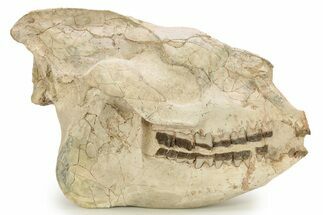This Specimen has been sold.
12.6" Fossil Running Rhino (Hyracodon) Skull - South Dakota
This is a jaw dropping, 12.6" long skull of Hyracodon nebrascensis. It was collected from the the White River Formation in South Dakota and would be approximately 30-34 million years old. This specimen includes the upper skull and mandible which are held together by the rock they were found in. The natural bone preserved well, though some sections of bone weren't recoverable, requiring restoration which I elaborate on below.
Teeth (Mandible): On the right side of the mandible, the distal-most premolar (P1) is restored, along with half of the adjacent premolar (P2) which required some restoration. The entire distal end of the mandible and the incisors have all been restored, the restoration of which continues around the mandible and stops at the premolars on the left side. The distal-most premolar (P1) on the left side has also been restored. The remaining teeth of the mandible are natural.
Teeth (Upper Jaw): The two distal-most premolars (P1 & P2) have been restored. The entire incisor bone and incisor teeth of the upper jaw are also completely restored. The restoration continues around the upper jaw, with the two distal-most premolars (P1 & P2) on the left side being restored as well. This restoration can be spotted just by sight, however a blacklight will assist in identifying these teeth in person (natural teeth fluoresce yellow).
Mandible bone: Other than the significant restoration along the incisors, the majority of the jaw is natural. There is a small triangular spot of gap fill restoration to the right side of the mandible. The remaining restoration is in the form of minor crack repair.
Upper Skull: The majority of the maxilla and nasal bones on both sides of the skull have undergone restoration which has a faint pink coloration under UV light. Both zygomatic bones are surprisingly intact and unrestored, though restoration can be found on both zygomatic arches as you approach the posterior half of the skull. The only remaining restoration worth mentioning is the bone along the sides and superior portion of the skull that attaches to the nuchal crest. The nuchal crest itself appears to be natural.
About 5 to 10% of the natural rock has been replaced with false rock that fluoresces white under UV. This specimen is accompanied by a display stand.
Teeth (Mandible): On the right side of the mandible, the distal-most premolar (P1) is restored, along with half of the adjacent premolar (P2) which required some restoration. The entire distal end of the mandible and the incisors have all been restored, the restoration of which continues around the mandible and stops at the premolars on the left side. The distal-most premolar (P1) on the left side has also been restored. The remaining teeth of the mandible are natural.
Teeth (Upper Jaw): The two distal-most premolars (P1 & P2) have been restored. The entire incisor bone and incisor teeth of the upper jaw are also completely restored. The restoration continues around the upper jaw, with the two distal-most premolars (P1 & P2) on the left side being restored as well. This restoration can be spotted just by sight, however a blacklight will assist in identifying these teeth in person (natural teeth fluoresce yellow).
Mandible bone: Other than the significant restoration along the incisors, the majority of the jaw is natural. There is a small triangular spot of gap fill restoration to the right side of the mandible. The remaining restoration is in the form of minor crack repair.
Upper Skull: The majority of the maxilla and nasal bones on both sides of the skull have undergone restoration which has a faint pink coloration under UV light. Both zygomatic bones are surprisingly intact and unrestored, though restoration can be found on both zygomatic arches as you approach the posterior half of the skull. The only remaining restoration worth mentioning is the bone along the sides and superior portion of the skull that attaches to the nuchal crest. The nuchal crest itself appears to be natural.
About 5 to 10% of the natural rock has been replaced with false rock that fluoresces white under UV. This specimen is accompanied by a display stand.
Hyracodons were hornless running rhinoceroses with large heads compared to their slight, pony-like bodies. They are an extinct line, though: we're sure you've noticed that there are no rhinos browsing the plains of North America today.
SPECIES
Hyracodon nebrascensis
LOCATION
South Dakota
FORMATION
White River Formation
SIZE
Length: 12.6" long, Width: 5.2", Height: 7.9"
CATEGORY
SUB CATEGORY
ITEM
#192112
We guarantee the authenticity of all of our specimens.
 Reviews
Reviews




















